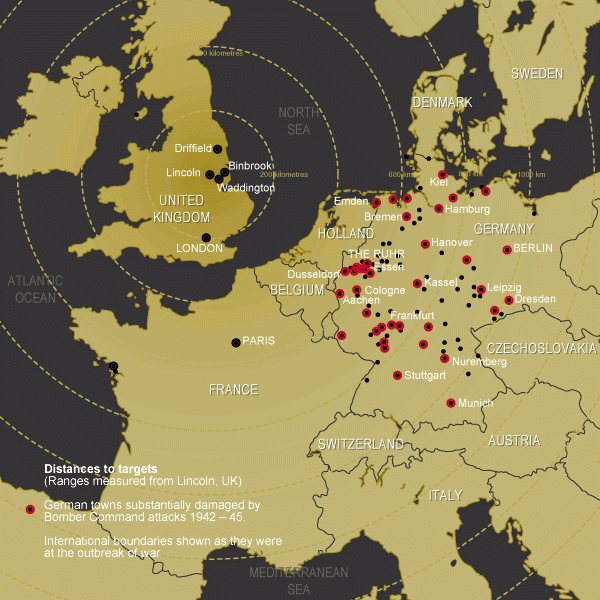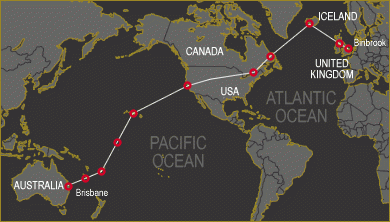Striking by Night - History of Bomber Command
From March 1941 there was a gradual build up of Australians in Bomber Command in Britain. Australian medium bomber squadrons began flying regular operations from September. No.460 squadron, the first Australian heavy bomber squadron, commenced operations with Lancasters in late 1942. Australians also served in RAF squadrons, and there were mixed nationality crews in all units.
The expansion of the RAAF numbers within Bomber Command coincided with the development of the bombing offensive of 1943 and the emergence of the Lancaster as the outstanding British bomber. Australians played a significant role in the main attacks on enemy cities and installations. Casualties were very high. At the height of the bomber offensive crews could hold little expectation of survival.
The number of RAAF aircrew reached a peak after the allies’ invasion of Europe in June 1944. It is estimated that 10,000 Australians eventually served with Bomber Command.
In October 1944 one of the Lancaster bombers, G for George was flown to Australia to promote the war effort.

Map showing main bombing areas in Germany
Operations
Bomber Command undertook a variety of tasks, from precision and selective target attacks to area bombing of cities. Short operations involved dropping sea mines off the European coast, and attacks on targets in France and western parts of Germany. Long flights could exceed eight hours, and take the bombers across Belgium, France, Netherlands, and Denmark to distant targets in Germany, and even over Italy.
All bombing operations were dangerous as most flights were over hostile and enemy occupied territory. The Germans responded with aggressive and effective defenses. Collisions were common and, over the target, there was the danger from falling bombs. Mechanical malfunctions and weather conditions added to the problems.
Among the notable operations, that against Cologne on 30 May 1942 is remembered as the first ‘one thousand bomber’ force raid. The raid on Peenemunde on 17 August 1943 was undertaken to disrupt German development of the V-1 flying-bombs and the V-2 rockets. G for George flew on the Peenemunde operation, and to Nuremberg on 30 March 1944. The latter was a disaster: ninety-five bombers, and many of their 7-man crews, were lost that night.
The three great bomber battles – The Ruhr, Hamburg, and Berlin – were all concentrated on large German industrial centres with the object of destroying built-up areas, communications and production. The main Ruhr targets were Duisburg, Essen, Cologne, Dusseldorf, Dortmund, and Bochum. Through these battles, Bomber Command still attacked other targets.
Even before the 1944 D-Day landings, the Germans had recorded 42 towns and cities that required substantial rebuilding as a result of concentrated allied bombing. Berlin and Hamburg had lost around 200,000 houses and many more suffered heavy damage. Cologne, Aachen, Hamburg, Kassel, Essen, and some others had total or heavy damage to over 50% of houses. For some cities worse was yet to come; in attacks on 13/15 February 1945, Dresden was almost destroyed and estimates of 30,000 to 100,000 people were killed.
Area bombing still required accuracy in marking the target. There were other places where pin-point precision was essential, such as the successful attacks on the Mohne and Eder dams, against the battleship Tirpitz and the rocket development facilities at Peenemunde.
George in Australia
The story of George was a morale booster. Just as the Spitfire became the symbol of defiance in the Battle of Britain, the Lancaster came to represent the allies’ will to win by taking the war to the heart of Germany. At the end of G for George’s long operational career it was flown to Australia to promote the war effort.
The famous bomber left Britain, with an experienced and decorated crew, on 11 October 1944. It became the main attraction during the Third Victory Loan tour throughout southern and eastern Australia. The aircraft was eventually retired in July 1945, and made its last flight to Canberra where it has remained ever since. The aircraft was first installed in the Memorial, in Aeroplane Hall, in 1955. More recently, extensive conservation work was completed in 2003.

Map from Binbrook to Brisbane
Pathfinders
In mid 1942 Bomber Command for med a special target finding and marking unit – the Pathfinder Force (PFF). An Australian, Group Captain Donald Bennett, was appointed to command. Pathfinders would use target indicator bombs. The bombers would concentrate on these markers. They could also be used along the route for navigation.
In some operations a PFF Master Bomber would remain over the target broadcasting advice to the other aircraft. Pathfinder s became essential to the bombing campaign. Members were regarded as an elite and wore a special badge.
